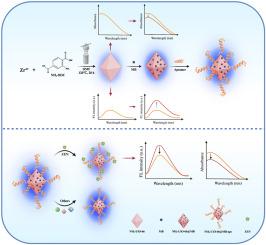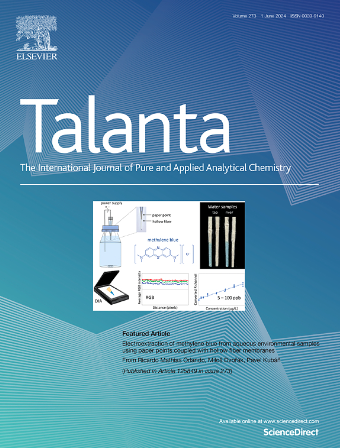一石二鸟:NH2-UiO-66@MB-based用于谷物产品中玉米赤霉烯酮敏感和快速检测的双峰适体传感器。
IF 6.1
1区 化学
Q1 CHEMISTRY, ANALYTICAL
引用次数: 0
摘要
玉米赤霉烯酮(ZEN)是谷类作物中普遍存在的真菌毒素,对食品安全和人类健康构成重大威胁。为了解决这一问题,迫切需要一种快速、灵敏、经济有效的检测方法。在这项研究中,我们开发了一种基于NH2-UiO-66@MB复合材料的新型双峰感应传感器用于ZEN检测。将亚甲基蓝(MB)包裹在NH2-UiO-66纳米颗粒内,增强荧光强度,并通过Zr-O-P键和库仑力将ZEN适配体附着在NH2-UiO-66上,形成门控效应。在ZEN存在的情况下,适体与ZEN结合,引发构象变化,释放MB,导致荧光强度和吸光度下降。在最佳条件下,双峰适体传感器具有宽线性范围(比色法为2.5 ~ 300 ng/mL,荧光法为0.125 ~ 200 ng/mL)和低检出限(比色法为1.16 ng/mL,荧光法为0.03 ng/mL)。此外,该传感器具有较高的特异性和重复性,在加标谷物产品中的回收率为97.43% ~ 103.71%。这些发现突出了所开发的双峰感应传感器作为一种快速、准确和经济有效地检测谷物产品中ZEN的新工具的潜力,有助于改善食品安全监测。本文章由计算机程序翻译,如有差异,请以英文原文为准。

One stone two birds: NH2-UiO-66@MB-based bimodal aptasensor for sensitive and rapid detection of zearalenone in cereal products
Zearalenone (ZEN), a prevalent mycotoxin found in cereal crops, poses a significant threat to food safety and human health. To address this issue, there is an urgent need for rapid, sensitive, and cost-effective detection methods. In this study, we developed a novel bimodal aptasensor based on NH2-UiO-66@MB composites for ZEN detection. Methylene blue (MB) was encapsulated within NH2-UiO-66 nanoparticles to enhance fluorescence intensity, and the ZEN aptamer was attached to NH2-UiO-66 via Zr–O–P bonds and Coulombic forces to create a gating effect. In the presence of ZEN, the aptamer bounded to ZEN, triggering a conformational change that released MB, resulting in decreased fluorescence intensity and absorbance. Under optimal conditions, the bimodal aptasensor exhibited wide linear ranges (2.5–300 ng/mL for colorimetry and 0.125–200 ng/mL for fluorescence) and low limits of detection (1.16 ng/mL for colorimetry and 0.03 ng/mL for fluorescence). Furthermore, the aptasensor demonstrated high specificity and reproducibility, with recovery rates ranging from 97.43 % to 103.71 % in spiked cereal products. These findings highlight the potential of the developed bimodal aptasensor as a novel tool for the rapid, accurate, and cost-effective detection of ZEN in cereal products, contributing to improved food safety monitoring.
求助全文
通过发布文献求助,成功后即可免费获取论文全文。
去求助
来源期刊

Talanta
化学-分析化学
CiteScore
12.30
自引率
4.90%
发文量
861
审稿时长
29 days
期刊介绍:
Talanta provides a forum for the publication of original research papers, short communications, and critical reviews in all branches of pure and applied analytical chemistry. Papers are evaluated based on established guidelines, including the fundamental nature of the study, scientific novelty, substantial improvement or advantage over existing technology or methods, and demonstrated analytical applicability. Original research papers on fundamental studies, and on novel sensor and instrumentation developments, are encouraged. Novel or improved applications in areas such as clinical and biological chemistry, environmental analysis, geochemistry, materials science and engineering, and analytical platforms for omics development are welcome.
Analytical performance of methods should be determined, including interference and matrix effects, and methods should be validated by comparison with a standard method, or analysis of a certified reference material. Simple spiking recoveries may not be sufficient. The developed method should especially comprise information on selectivity, sensitivity, detection limits, accuracy, and reliability. However, applying official validation or robustness studies to a routine method or technique does not necessarily constitute novelty. Proper statistical treatment of the data should be provided. Relevant literature should be cited, including related publications by the authors, and authors should discuss how their proposed methodology compares with previously reported methods.
 求助内容:
求助内容: 应助结果提醒方式:
应助结果提醒方式:


